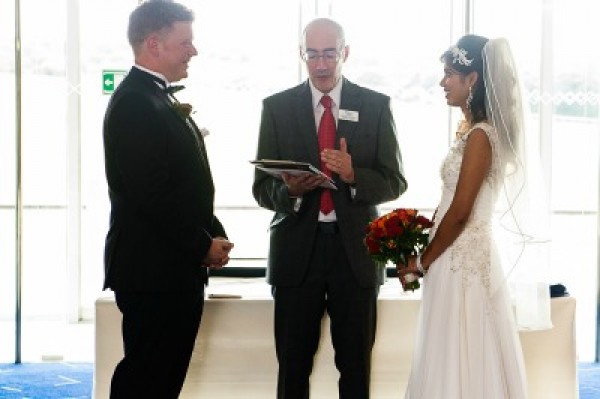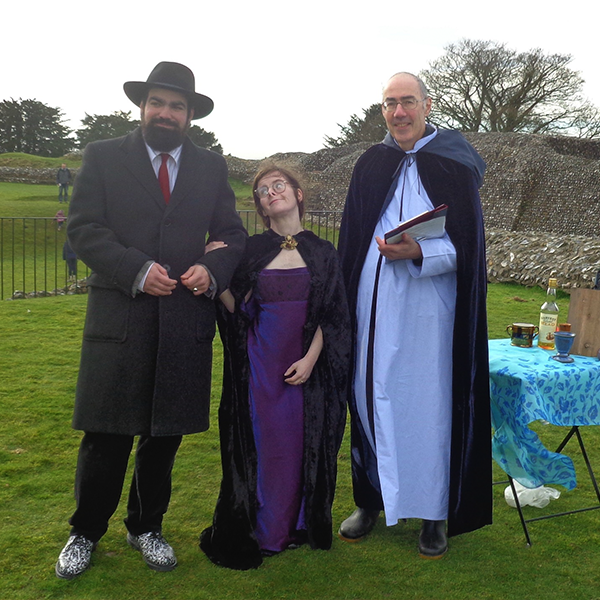
by Michael | Jan 5, 2016 | Blog
Whether it be a priest, registrar or civil celebrant, your officiant can make or break your wedding day. It’s so important that you can relate to them and trust them. With a priest or a registrar, you don’t have much choice. But you can choose your civil celebrant.
The vital question therefore is: how do I choose the right one?
Which officiant?
Obviously, your wishes, beliefs and budget are all factors.
A religious ceremony is just that – and it follows a set formula which allows little room for personalisation.
The same applies to register office weddings – except that there may be no religious mentions at all.
To get the best of both worlds, you can combine register office (or a religious service) and civil ceremony. For example, hold the (legal) wedding the day before – or immediately before – and then have the ceremony that actually fits with your dreams.

Would you like something a bit different, perhaps?
You certainly should be free to choose the type of ceremony you’ll be having – especially on the most important day of your life. You may have to compromise (with parents, for example). However, ideally, the service should be a deeply personal experience that reflects both your and your partner’s beliefs, values and style.
That’s why you may opt for a civil celebrant. So how do you choose the right one for you?
Find your Civil Celebrant
You may already know of a celebrant through a referral, say. Otherwise, you will probably turn to Google. You can look under affiliated groups (eg AOIC, British Humanist Association, UKSoC, etc.). People listed there will have been trained and offer minimum (actually, often excellent) standards. Otherwise, you might key in “Civil Celebrant Harrow” and, hopefully, “Vows That Wow” will appear!
Check your Celebrant out
Once you’ve found a possibility or two, have a look at their website. Read the testimonials, but, possibly more important, see their video. This will give you an idea of the sort of person they are. You will not want to work with someone you feel uncomfortable with!
What to find out
Having settled on your celebrant, these are things you need to know:
- First, establish if the celebrant is free on the date you have in mind
- If so, check if they will travel
- Ask about legal requirements, as licensed premises have strict rules
- Of course, you need a quote (although trusting and liking them should be more important)
- Ask how they operate – ie is there an initial meeting (where?) – and what the fee includes
- Try and get a sense of their experience, enthusiasm and character (just as there are many different sorts of ceremonies, so civil celebrants have different personalities)
- Check how flexible the ceremony may be (eg can you write your own vows?)
- You may want to ask about length of ceremony (although this will very much depend on your requirements)
If you feel happy that you would like this celebrant to conduct your ceremony, then your gut feeling is probably the thing to go with. However, make sure you read and understand their Terms & Conditions. There shouldn’t be any nasty surprises, especially with a bona fide professional, but it’s always as well to be vigilant.
Working with a professional will be a pleasure. You will be free to enjoy the unforgettable, unique experience that is so precious. A good civil celebrant should be able to provide precisely what you are looking for.
by Michael | Oct 28, 2013 | Blog
Regular readers of my blogs will know that I write and conduct personalised life-cycle ceremonies. Not just weddings, civil partnerships, vow renewals, ring blessings, baby-namings and the like, but also funerals.
Cheerful as my blogs tend to be, this one will consider an aspect of death: what do you want to happen to your body at the end?
Of course, this is something I discuss with people (and their families) in their lifetime; I then write the service and eulogy that they actually want.
It’s no more ghoulish than writing a will, and it’s certainly as practical. You’re simply ensuring that your wishes are carried out when you’re no longer around to control things.
Choices
Most people think that a funeral is prescribed. But the only things that actually need to be done when there is a death are legal registration and disposal of the body. Although there are certain stipulations, there is a surprising choice of methods open to you.
The Conventional
Conventionally, you have a religious service delivered by your church, synagogue, temple etc. This will often entail burial, but increasingly nowadays, cremation, and the minister will usually conduct a prescribed service that allows little individuality.
Alternatives
Independent Celebrants
More and more, for those who do not want a full religious service (whether out of respect for the deceased or as the family’s choice) , there is the possibility of a unique, tailor-made service conducted by an independent celebrant. Funeral Directors frequently can recommend such an officiant. The celebrant should visit the next-of-kin and discuss the family’s wishes and learn about the deceased, so as to be able to write an appropriate celebratory service, approved beforehand by the family, and conduct it on the day.
These services are often held in crematoria, but they can take place in cemeteries or natural burial grounds, or even in homes as memorial services.
DIY
There is no space to go into this here, but, as long as pollution and health and safety laws are followed, you can bury someone in your back garden and conduct the ceremony yourself. I don’t recommend it, but, as I have said, there is some freedom as to how – or whether – you conduct a funeral.
Modern alternatives
Wear your beloved!
When your loved one has died, it is possible for their cremated remains (which contain a lot of carbon) to be transformed into precious stones, including diamonds. So your loved one, in the form of a ring or necklace, can still be with you wherever you go!
Give your beloved a real send-off!
Your loved one’s ashes can be sent off into the earth’s orbit or, for quite a price, launched into outer space. I’m not sure about the ‘carbon footprint’ here, but it IS an option …
Become an atoll!
Ashes can be cast into a 100% natural cast reef mould, lowered into the ocean to eventually become a coral reef. Environmentally-friendly and a creative (if expensive?) idea.
All at sea
You can be buried at sea, as in a garden – see above – but there are regulations you need to conform to.
Resomation
Another more environmentally-friendly suggestion is resomation, which is a water-based process which reduces the body to soft bone, easily crumbled. The bone powder can be treated in the same way as cremated remains.
Cryomation
This process uses liquid nitrogen to freeze the body, which is then fragmented, freeze-dried and rendered rapidly compostable in a shallow burial. This must be the greenest process of all.
Cryogenic freezing
Finally, human remains can be frozen, using liquid nitrogen, without damaging human tissue. In theory, the body will be preserved until, with advances in medical knowledge, it will be able to be treated and eventually reanimated.
Take your pick!!
Michael Gordon can help prepare and conduct a tailor-made life-cycle ceremony in or around London or, indeed, in Europe.
by Michael | Apr 9, 2013 | Blog
A Church wedding
Being faced with your wedding, especially if it’s a big event, can be pretty unnerving. Fun, exciting and wonderful – but unnerving. There are so many questions to be answered. I’d like to offer a guide to your wedding.
What happens at the Church?
Assuming you have chosen a Church wedding, you will need ushers (who should be the first to arrive, naturally). They should guide the bride’s family and friends to the left side of the altar and the groom’s to the right.
The groom and best man should arrive at least 15 minutes before the ceremony so the photographer can take a few shots before they enter the church (they will occupy the front right-hand pew).
Bridesmaids arrive about 10 minutes before the ceremony. Together with the bride’s mother (normally), they wait at the church door for the bride to arrive. (Another moment for the photographer?)
The bride, along with her father-to-be, will be greeted on arrival by the officiant. The photographer will certainly want to be in attendance here too!
Who goes where?
The bride’s father, family, and any relations and friends will have the officiant ahead of them on their right; obviously, the officiant will be ahead, but to the left, of the best man, groom’s family and selected relations and friends. The bride and groom, chief bridesmaid and bridesmaids will be central, facing the officiant in front of the altar.
The bride and groom followed by bridesmaids (and/or pageboys) will lead out at the end of the ceremony. Behind them, on the left, will be the chief bridesmaid, bride’s mother and groom’s mother; on the right, the best man, groom’s father and bride’s father.
The above follows the traditional order. Of course, a celebrant-led wedding will offer more flexibility and choice .
Next time, I’ll advise on the reception.
Michael is a celebrant based in London.


